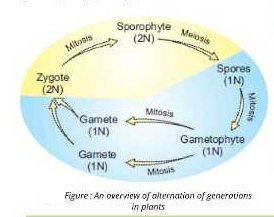Q5. Explain the sexual reproduction in plants.
1. Sexual Reproduction
Sexual reproduction involves the production of gametes and their fusion i.e., fertilization.
2. Prodraction of Gametes
Gametes are produced in special structures in plant body.
Sexually Reproducing Plants
i. Non-Seed Producing plants (Mosses and ferns) :
ii.. Seed Producing Plants :
a. Gymnosperms
b. Angiosperms (flowering plants)
4. Use of Different Methods for Fertilization
Plant groups use different methods for bringing the sperm and egg cells together.
a. In Mosses and Ferns
Sperms are motile and can swim to egg cells. Therefore, these plants require water (in the form of dew or rain) for sexual reproduction.
b. Gymnosperms and anagiosperms .
These plants have special methods for carrying their sperms to egg cells. They do not need
water for reproduction.’
5. Alternation of generation
In the life cycle of flowering plants, two different generations alternate with each other. One generation is diploid and produces spores called sporophyte. The other generation is, haploid and produces gametes called gametophyte generation. This phenomenon in which two generations alternate with each other during life cycle is called alternation of generation.

6. Sporophyte Generation
i. Dominant In most plants, sporophyte generation is dominant. It means that it is big in size and is independent. –
ii. Production of Spores
Sporopyte produces haploid spores by meiosis and spores develop into gametophyte.
7. Gametophyte Generation
i. Small in size:
It is small in size and depends upon sporophyte.
ii. Production of gametes
It produces gametes by mitosis. The male and female gametes fuse and form diploid Zygote. The zygote undergoes repeated mitosis and develop into a new diploid sporphyte.
8. Structure of flower
Flower is the reproductive structure. The flower components are arranged in the form of whorls. The outer two whorls in a flower are the non-reproductive whorls while the inner two whorls are the
reproductive whorls.
(i) Calyx
It is the outermost whorl and usually green in colour. Its individual units are called sepals.
(ii) Corolla
It is the second whorl and is often coloured brightly. Its individual units are called petals. It attracts the insects which are the agents of pollination.
(iii) Androecium
It is the male reproductive part and its units are called stamens. Each stamen has a thread like filament at the end of which anther is attached. Another has pollen sacs in which haploid microspores (pollen grains) are produced during meiosis. Microspore makes the male gametophyte generation. The nucleus of microspore undergoes mitosis and produces two nuclei i.e. tube nucleus and generative nucleus. The generative nucleus produces two sperms by mitosis. So a germinated microspore has a tube nucleus and two sperms. This is the male gametophyte.
(iv) Gynoecium
It is the female reproductive part of flower. Its units are called carpels. Each carpel is made up of basal ovary, middle style and upper stigma. Inside ovary, there is one to many ovules. Each ovule has one haploid macrospore (produced by meiosis). Macrospore undergoes mitosis and produces an egg cell and some associated structures. This is the female gametophyte.
9. Pollination
When pollen grains mature, they are transferred to stigma and it is called pollination. On reaching the stigma, the tube nucleus of pollen grain makes a pollen tube. The pollen tube contains a tube nucleus and two sperms.
Entry of Sperms in Female gametophyte
The tube grows through style and ovary and enters ovule. Here, it bursts and releases the sperms. Both sperms enter the female gametophyte.
10. Double Fertilization
One sperm fuses with egg and forms a diploid zygote, the other sperm fuses with diploid fusion nucleus and forms a triploid (3N) nucleus called endosperm nucleus. Since the process of fertilization involves two fusions, it is called double fertilization.

11. Formation of embryo and Endosperm
Zygote develops into embryo and endosperm nucleus.
12. Formation of seed and Fruit
Ovule then becomes seed and ovary changes into fruit.
13. Formation of a new plant
When seeds mature, they are dispersed. If seeds get suitable conditions, their embryos develop into new plants.

![]()